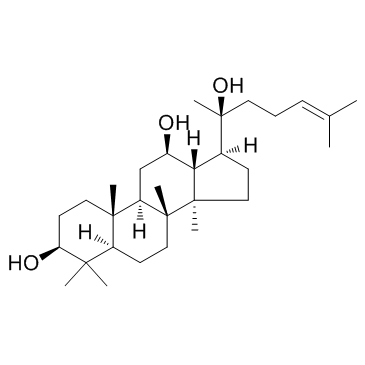30636-90-9
| Name | (20S)-protopanaxadiol |
|---|---|
| Synonyms |
Protopanaxadiol
Protopanaxtriol (20S)-Protopanaxadiol 20(S)-Protopanaxdiol (3β,12β)-Dammar-24-ene-3,12,20-triol PROTOPANAXDIOL Dammar-24-ene-3,12,20-triol, (3β,12β)- Protopanaxadiol, 20S- |
| Description | (20S)-Protopanaxadiol (20-Epiprotopanaxadiol) is an aglycon metabolic derivative of the protopanaxadiol-type ginseng saponin; apoptosis inducer.IC50 value:Target: apoptosis inducer(20S)-Protopanaxadiol was used to induce cytotoxicity for two human glioma cell lines, SF188 and U87MG. For the SF188 cells, (20S)-Protopanaxadiol activated caspases-3, -8, -7, and -9 within 3 h and induced rapid apoptosis, which could be partially inhibited by a general caspase blocker and completely abolished when the caspase blocker was used in combination with an antioxidant. (20S)-Protopanaxadiol also induced cell death in U87MG cells but did not activate any caspases in these cells [1]. aPPD was able to inhibit P-gp activity as potently as verapamil on MDR cells. The blockage of P-gp activity was highly reversible as wash-out of aPPD resulted in an immediate recovery of P-gp activity. Unlike verapamil, aPPD did not affect ATPase activity of P-gp suggesting a different mechanism of action [2]. |
|---|---|
| Related Catalog | |
| References |
| Density | 1.0±0.1 g/cm3 |
|---|---|
| Boiling Point | 559.5±40.0 °C at 760 mmHg |
| Melting Point | 211 °C |
| Molecular Formula | C30H52O3 |
| Molecular Weight | 460.732 |
| Flash Point | 226.1±21.9 °C |
| Exact Mass | 460.391632 |
| PSA | 60.69000 |
| LogP | 7.59 |
| Vapour Pressure | 0.0±3.5 mmHg at 25°C |
| Index of Refraction | 1.529 |
| Hazard Codes | Xi |
|---|


